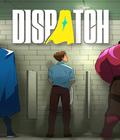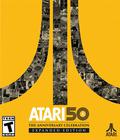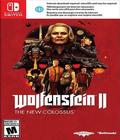Buy Wolfenstein II: The New Colossus
What determines a good port? This may be the most crucial question when talking about the Nintendo Switch. So far, the system has seen its fair share, but that's expected of new consoles. Developer Panic Button has become somewhat of a go-to expert for Switch ports after completing what many dubbed an "impossible port" by bringing Doom to the handheld hybrid. Rocket League soon followed, and now we're treated to a portable version of Wolfenstein II: The New Colossus. Keeping in mind that Doom struggled to maintain consistent performance with heavily downgraded visuals, the prospect of Wolfenstein running on the same system was met with skepticism and a tiny bit of hope. The result is better than expected.
Let's start at the beginning. Wolfenstein II takes place right after the conclusion of the first part and series reboot, The New Order by Machine Games. The Nazis won the war and have taken control of the world and, most prominently, the United States. We take control of a heavily wounded B.J. Blazkowicz, who has to finish what he started and reignite the resistance movement to topple the Nazi regime once and for all. It's a tall order that's full of over-the-top action, memorable characters, good run-and-gun gameplay, a decent story, and a distinct style that clicks with the franchise.
Wolfenstein II is a gory shooter that lets you brutalize Nazis by the hundreds. That's what the series has been about since its early days. The surprise is that Machine Games' reboot turned it into a story-heavy, character-driven, action fest that oozes charm. Wolfenstein II ups the ante in presentation and provides us with a good story arc that introduces even more memorable characters. The most impressive feat of all may even be the way the Machine Games developed a muscle-heavy B.J. Blazkowicz from silent Nazi killer into a somewhat believable protagonist who has sentimental motivations for his actions. Sure, some scenes miss the mark, but it made us care about the characters and want to play to the very end.
Wolfenstein's gameplay hasn't changed that much — point your gun and shoot a Nazi — but it doesn't feel dated or bland. If anything, Doom established that going back to the simpler times of the shooter genre can be liberating and fun. Wolfenstein is a straightforward shooter experience that plays best when you disregard cover mechanics and stealth. We can carry all weapons at once, we can dual-wield them, and we have a cinematic melee attack. Thrown together, they encourage offensive gameplay with some cover usage.
Wolfenstein very much resembles a corridor shooter, so the gun gameplay feels very tight. Enemies are thrown in front of your barrel with enough explosives to send several rockets to the moon. There is always something exploding, bleeding or screaming, and it makes the fighting feel very visceral and impactful. The gun arsenal is just as diverse, making you the definitive Nazi death machine. Dual-wielding two semi-automatic shotguns is as devastating as it sounds. Disintegrating Nazi soldiers with laser beams has a very satisfying feel to it and will never get old. However, the gun gameplay can become quite overwhelming, especially in busy firefights. While there are hit indicators, it can be frustrating to discern where bullets are coming from in a poorly lit environment where guys dressed in black metal are standing in front of black metal structures. Another minor annoyance is the somewhat half-hearted implementation of stealth that doesn't feel like it was ever a viable. It doesn't feel right or control well, and the stages don't seem like they'd accommodate a serious stealth approach.
Ultimately, this may make the game sound a bit repetitive, both in environments and gameplay design. Most stages incorporate the familiar mechanics of entering a level, looking for the commanders, and taking them out. Doing so stops reinforcements from spawning and makes your life easier. While Wolfenstein II introduces more colors and variety in its environments, there is only so much it can do to illustrate different Nazi bases. We may be a one-man army infiltrating a Nazi base, but all we find are repeating patterns in design and behavior.
The game does try to shake things up before things get too repetitive. Evolving enemy types and the story make things interesting enough, even if the core gameplay seems to stagnate. Boss fights are a highlight, as they should be, but they are quite rare, so some stages feel underwhelming. After I had gone through an amazing, large-scale firefight that felt like it should lead to a climactic finale, it led me to a door that gave me a cut scene and transitioned to the next level. The pacing often feels off because of that, hindering what is otherwise a very enjoyable campaign.
In between missions, we can freely roam the U-Boat that we reside in with our resistance friends, completing side-quests, use the shooting range, and hanging out with the rest of the gang. If you want to immerse yourself, there are plenty of conversations here and even more collectibles to be found. The only downside to a hub area this large is that it can sometimes be tough to find out where you're meant to go for the next mission — even if you consult the map.
Apart from the fact that Wolfenstein's story can be experienced in two separate ways (based on one decision at the beginning of the first game), its wealth of hidden collectibles and multiple difficulty settings offer enough to replay the game at least once. Collectibles come in many shapes and forms, but not all of them feel like they accomplish much apart from raising the completion percentage. When performed a certain number of times, some challenges and tasks grant permanent improvements, such as increased crouch speed or higher ammo capacity. It also pushes the player to complete the challenges and mix up the gameplay. Weapons can be modified with upgrade kits, making our arsenal even more powerful and encouraging us to return and find them at a later stage.
As a sum of its parts, Wolfenstein II is a highly enjoyable shooter. It manages to overcome its shortcomings with a blend of gameplay, story and style. What's just as important is the technical implementation. It's an incredibly gorgeous and smooth game to play on the PC, PS4 and Xbox One, but does that hold true when ported to the Switch? The answer is a very careful, "Maybe."
Panic Button's Doom port suffered from a few nasty hiccups. It often had slowdowns, especially in higher and enemy-heavy difficulty settings, while at the same time downgrading to blurry resolution settings, low-res textures, and weirdly compressed sound. At the same time, one could argue that Doom's muddy appearance and color scheme did hide a few of the necessary downgrades. That also means that we'll take a more critical look at the developer's second outing here, and we're happy to say that the outcome is way more polished.
Wolfenstein II on the Switch has a different focus: disregard the resolution, keep the visuals intact, and prioritize the frame rate. The result is a game that hits close to 30 fps more often than Doom did, while still clocking in under 30 most of the time. It remains reasonably stable. Real hitches are few and far in between, and they mostly occur in the larger outdoor areas.
What's far more noticeable than the frame rate is the resolution, especially in handheld mode. Wolfenstein II has some of the lowest resolutions I have seen in any game on the Switch (including Doom and Xenoblade 2, both of which can get incredibly low), resulting in sometimes downright ugly scenes where faces of characters are blurred beyond recognition. That may all be forgiven in the heat of battle, but in-game cut scenes lose a lot of flair because of it. The visual fidelity is far better in docked mode, so it's recommended to play it exclusively on the TV.
While Panic Button met its goal — keeping visuals intact and hitting close to 30 fps — the resolution can leave a sour taste. One can argue that, if the game is only fun to play in docked mode, why buy the Switch version at all? That's a decision that gamers will have to make. The game is playable, but it's incredibly blurry at times. If you have no other capable platform at your disposal, this may still be a good option. One aspect that hasn't been compromised in this version is audio, music and voices, which are thankfully of a much better quality than they were in Doom.
Wolfenstein II also adds two Switch-exclusive features: HD Rumble and gyroscopic aiming. HD Rumble is a nice addition, although it's not the most impressive implementation we've seen thus far. Gyroscopic aiming, on the other hand, is a huge advantage over other versions. If you end up playing in handheld mode, the ability to fine-tune your aiming with precise movements is invaluable for this genre, and it's a welcome return after it was added to Doom earlier this year.
Is Wolfenstein II: The New Colossus on the Nintendo Switch for you? There are several questions you'll have to answer. Is it the best version of the game? Not by a mile. Is it enjoyable? Yes, and that may be all you need to know. It is a playable, albeit technically flawed, version that runs on a tablet. If you can play it elsewhere, you should. If you can't, the Switch iteration does a serviceable job of sharing B.J. Blazkowicz's action-packed journey.
Score: 7.4/10
More articles about Wolfenstein II: The New Colossus











 Wolfenstein II: The New Colossus sends you to Nazi-controlled America, where you must free the world from the evil empire's stranglehold.
Wolfenstein II: The New Colossus sends you to Nazi-controlled America, where you must free the world from the evil empire's stranglehold.















